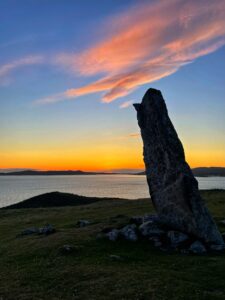
Clach Mhic Leoid, or the Macleod Stone, stands alone on the headland of Nisa-bost, overlooking the Sound of Taransay. It may be all that remains of a once-great stone circle. This spot has drawn human attention for millennia; artefacts from every age have turned up nearby. One survey even hints at the buried remains of an Iron Age structure beneath the sandy rise between the stone and the sea1Clach Mhic Leoid. Canmore ID 10532 http://canmore.org.uk/site/105322Rivett, Mary Macleod. The Outer Hebrides: A Historical Guide.Birlinn Ltd. 2021..
The stone rises about three metres, streaked with quartz and feldspar, though the lichen makes you work to see it. Archaeologists say its base is ringed with packing stones. A pair of upright slabs once flanked it, but they seem to have disappeared beneath the shifting sand sometime after the early 20th century. Some suspect a burial cairn once stood here too. Two Viking graves have already been uncovered, the result of wind and rain erosion, raising the possibility of a small cemetery from that period3Traigh Iar Grave. Canmore ID 261433 http://canmore.org.uk/site/261433.
Whether that is true or not remains buried with the rest—only a proper dig will tell.
- 1Clach Mhic Leoid. Canmore ID 10532 http://canmore.org.uk/site/10532
- 2Rivett, Mary Macleod. The Outer Hebrides: A Historical Guide.Birlinn Ltd. 2021.
- 3Traigh Iar Grave. Canmore ID 261433 http://canmore.org.uk/site/261433
